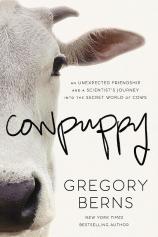Cowpuppy: An Unexpected Friendship and a Scientist’s Journey into the Secret World of Cows
Review
Cowpuppy: An Unexpected Friendship and a Scientist’s Journey into the Secret World of Cows
Reading the title of this book, one might wonder what exactly Gregory Berns is writing about. To really understand this endeavor, you must take note of the subtitle: "An Unexpected Friendship and a Scientist's Journey into the Secret World of Cows." If you aren't interested in animals, COWPUPPY is not for you. If you are worried that it espouses veganism, that’s not what Berns does. In fact, he admits to occasionally eating meat and feeding it to his dogs. But he writes about his cattle not just from a scientist's point of view, but as a behaviorist. His cows are not just farm animals or tools, they are his friends.
This makes sense when we realize that Berns is a professor of psychology at Emory University. He directs the Center for Neuropolicy and the Facility for Education and Research in Neuroscience. He has written many other books, including the bestseller HOW DOGS LOVE US. So during the COVID pandemic, when he and his wife moved to a farm outside Atlanta, and he decided to get some cows so he wouldn't have to mow their fields, it makes sense that he interacted with the bovines and got to know them better.
"COWPUPPY is in no way light reading, but it isn’t a slog either. It's entertaining, informative and even humorous at times.... It's a delightful experience."
From the start, Berns disabuses us of the notion that cows are just big dogs, although his cattle are smaller than the average cow we might imagine. He bought miniature zebus for his farm. They are Brahman cattle with a large hump between their shoulders, and because they originate from Asia, they adapt well to the heat of Alabama. The ad he responded to was for two cows and a bull, and while he didn't really want a bull, he got all three. Both cows were pregnant.
Over the course of COWPUPPY, we learn a lot about the history of cattle, their physical characteristics, their behaviors and their personalities. Bern's writing style is folksy. The dialogue and the narrative are interspersed with the science. Renderings of the brains of different animals, along with details regarding their intelligence, make for an enjoyable and educational reading experience.
Berns often compares cows to dogs, which makes sense because much of his professional life was spent studying dogs. I never thought about the fact that while both dogs and cows are animals that live in groups (packs and herds), "the semantic difference is that pack describes a group of predators, whereas herd is a group of prey. Packs and herds behave differently. Prey animals herd together for protection. When under threat, the individual that stands out is at greater risk of being killed." He goes on to explain why, though dogs and cows are group animals, the behavior of each individual within that group is very different. This concept was reinforced when I thought back to a trip to Kenya where we saw a wildebeest get killed by a pride of lions (a mama and her adolescent cubs) when he ventured too far from his herd. To cattle, the herd represents safety.
Another fascinating aspect about cows is how their eyesight, specifically their peripheral vision, affects how they interact with the world around them. We see through Berns’ eyes the progression of his relationship with the different cows and the bull, watching him learn hands-on about birthing a calf. We also observe his epiphany when he learned about Bud Williams, a cowboy who worked with cattle and learned to handle them not by force, but by letting them teach him what they wanted. Bud then used their desires to get them to do what he needed them to do. His mantra was "slow is fast," meaning that by taking things slowly, the results will happen quicker. This is repeated over the course of the book.
I appreciate the chapter about cows and what their purpose is. Berns used his cows for grass control, but also for a lot more. They provided cow therapy for him, as well as being his research subjects. When people tour his farm, he says that the cows were meant to help improve the land, not because he was raising them for meat. He also explains where most of America's meat comes from: feedlots or concentrated animal feeding operations (CAFOs), where there might be hundreds of thousands of animals crowded together. Frighteningly, he writes, "Despite the EPA's regulation of the pollutants these operations release, there is scant data on the number of animals being processed at these facilities, or even the number of CAFOs." The reason this is important is twofold: animal welfare and the environmental impact from such horrific conditions.
Berns explains why purchasing local meat that has been ethically raised and slaughtered is the better route than buying whatever is on sale at your nearest big-box supermarket. He suggests supporting your local farms where animals are treated well.
At the end, there is a brief history of the cow and a bulleted appendix about what cows are like, how they think, their body language and more. There also is a glossary and notes, all demonstrating the facts and science that went into this book.
COWPUPPY is in no way light reading, but it isn’t a slog either. It's entertaining, informative and even humorous at times. We feel as if we've been invited into Berns' life and onto his farm to meet the herd, stroke their "brisket" and watch as he interacts with them. It's a delightful experience.
Reviewed by Pamela Kramer on September 21, 2024
Cowpuppy: An Unexpected Friendship and a Scientist’s Journey into the Secret World of Cows
- Publication Date: August 20, 2024
- Genres: Memoir, Nonfiction
- Hardcover: 248 pages
- Publisher: Harper Horizon
- ISBN-10: 1400338808
- ISBN-13: 9781400338801




